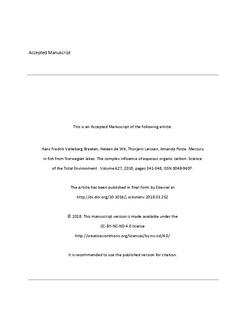Mercury in fish from Norwegian lakes: The complex influence of aqueous organic carbon
Journal article, Peer reviewed
Accepted version
Date
2018Metadata
Show full item recordCollections
- Publikasjoner fra Cristin - NIVA [2148]
- Scientific publications [1172]
Original version
Science of the Total Environment. 2018, 627 341-348. 10.1016/j.scitotenv.2018.01.252Abstract
Mercury (Hg) concentrations in water and biota are often positively correlated to organic matter (OM), typically measured as total or dissolved organic carbon (TOC/DOC). However, recent evidence suggests that higher OM concentrations inhibit bioaccumulation of Hg. Here, we test how TOC impacts the Hg accumulation in fish in a synoptic study of Methyl-Hg (MeHg) in water and total Hg (THg) in perch (Perca fluviatilis) in 34 boreal lakes in southern Norway. We found that aqueous MeHg (r2 = 0.49, p < 0.0001) and THg (r2 = 0.69, p < 0.0001), and fish THg (r2 = 0.26, p < 0.01) were all positively related with TOC. However, we found declining MeHg bioaccumulation factors (BAFMeHg) for fish with increasing TOC concentrations. The significant correlation between fish THg concentrations and aqueous TOC suggests that elevated fish Hg levels in boreal regions are associated with humic lakes. The declining BAFMeHg with increasing TOC suggest that increased OM promotes increased aqueous Hg concentrations, but lowers relative MeHg bioaccumulation. A mechanistic understanding of the response from OM on BAFMeHg might be found in the metal-complexation properties of OM, where OM complexation of metals reduces their bioavailability. Hence, suggesting that MeHg bioaccumulation becomes less effective at higher TOC, which is particularly relevant when assessing potential responses of fish Hg to predicted future changes in OM inputs to boreal ecosystems. Increased browning of waters may affect fish Hg in opposite directions: an increase of food web exposure to aqueous Hg, and reduced bioavailability of Hg species. However, the negative relationship between BAFMeHg and TOC is challenging to interpret, and carries a great deal of uncertainty, since this relationship may be driven by the underlying correlation between TOC and MeHg (i.e. spurious correlations). Our results suggest that the trade-off between Hg exposure and accumulation will have important implications for the effects of lake browning on Hg transport, bioavailability, and trophodynamics.
Description
Embarg ountil 03 February 2020

